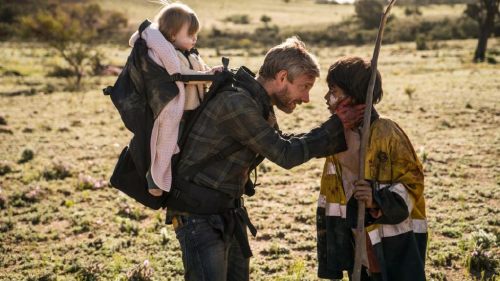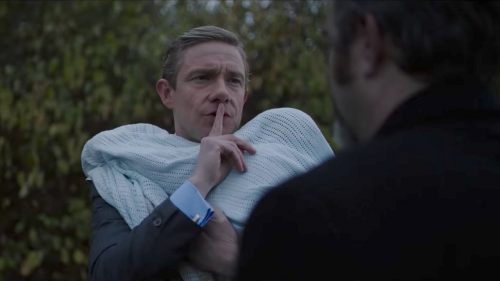The CARGO Directors Discuss Putting Martin Freeman Through The Wringer
In Cargo, which just dropped on Netflix, things go from bad to worse for Andy (Ghost Stories’ Martin Freeman). A zombie pandemic has spread through rural Australia, his wife becomes infected, then he suffers the tragic bite. As the soulless Virals roam the arid lands, can Andy get his newborn baby to safety before he loses his last traces of humanity?
Aussie co-directors Ben Howling and Yolanda Ramke first explored the undead world of Cargo in 2013 as a short film, which emerged as a huge YouTube sensation. Investors soon came knocking with the offer to turn Cargo into a feature, and the completed movie made its international premiere at April’s Tribeca Film Festival.
In the following interview, the filmmakers begin by discussing Cargo’s metamorphosis.
Q: How did Cargo transform from short film to feature?
Ben Howling: So it started out just brainstorming, where we kind of came away with just an image of a zombie with a baby on his back. Three months later, Yolanda came up with the short film script, we shot it, got it into Tropfest and then it became this really crazy viral success. And then after that, CAA reached out to us and then that opened the door to us expanding it into a feature.
Q: Was it difficult to find a new approach to the zombie genre?
Yolanda Ramke: That’s the challenge, isn’t it? Because it is such a popular genre. And even at the time that we started developing this story, The Walking Dead was in its second season. What we learned about the short was that audiences really connected with the parent-child love story, which is the driving beating heart of the film. And then the other element we hadn’t maybe seen before was the presence of Indigenous survivors in a dystopian world. That inspired us to look into aboriginal culture, and how we might be able to include that as a voice in the film. A culture that has such a rich history of being able to live off the land and survive. And Cargo also has thematic threads that relate to the colonial history of our country. Those factors were really interesting and worth exploring.
Q: I love the whole father-daughter dynamic of the film. Why did you decide to emphasize that?
BH: We became aware of just how much that universal theme of a parent-child relationship really carried the short film, which was very light on dialogue. Everyone around the world knows that feeling. We made sure we lifted that to the surface and made it the priority for the feature. We expanded on that theme by having a subplot with Thoomi [Simone Landers] and her father, coming at it from both angles. Father-daughter, daughter protecting father.
Q: Was this an easy film to get financed?
YR: It took a little while. We were really, really fortunate to have our Australian producers at Causeway Films, Samantha Jennings and Kristina Ceyton, on board to drive that side of it. It was about a three-year process from the initial conception of the treatments of what the feature film would be to actually getting to a place where we were able to move into preproduction. It was a combination of financing strategies. We had some presales out of the UK, we had private investment. And in Australia we have a lot of government screen agencies that are there to support certain projects and who helped put the budget together. And then, of course, when you have an actor of Martin Freeman’s caliber attached to the project, that also opens doors. All the financing puzzle pieces fell into place.
Q: What attracted Martin Freeman, known for many big movies and TV shows [Black Panther, The Hobbit, Sherlock], to a more modestly-budgeted project like yours?
BH: Part of the lure was the chance to play a father, as he has two young boys. It was a huge opportunity for him to be a bit more of an alpha, one who could rise to the occasion. The challenge of being a parent and also ensuring the survival of his daughter. It was a bit more of a physical role for him. Shooting in Australia was probably a bit of a novelty as well.
Q: How hard was it to cast Thoomi, the young Indigenous girl?
YR: It was pretty tricky. Our casting director, Nikki Barrett, has cast a lot of films that required Indigenous children to play very prominent roles. So she had great connections to a lot of the more rural communities in Australia. So the approach was to have kids send in self-tapes, shot on their mobile phones in their backyards with their parents. We saw hundreds of those and whittled it down to four girls, who we flew to Adelaide to do a weekend workshop. From the get-go, Simone was just a standout. She just really took to it. She’d never acted before. She checked all the boxes for the character in terms of having this kind of independence, but also this mischievousness and soulfulness. And she was enthusiastic; she stood out and then the camera on her eyes just hooked you in immediately. We felt very lucky to have found her. That was right down to the wire. We cast her about three weeks out from shooting, which is pretty tight. That was nerve-wracking at the time.
Q: The Indigenous people’s “soul stealing” myths are an interesting element in the film.
YR: When we were in the early phases of research, we came across the idea of what is the equivalent of a Native American medicine man, but here in Australia we called them clevermen. A cleverman can actually take a person’s soul, essentially untether it from the body and steal it. Therefore, that person is left wandering around like a shell of a human. Gradually the mental faculties and their physical form just deteriorate, and we thought, “Oh, my God, that is a zombie!” That is essentially what a zombie is.
So we found that idea very interesting, but at the same time, we also didn’t want to make the mistake of going down the path of trying to attribute this outbreak to [soul-stealing] and be respectful in how we handled the cultural aspects of the film. But as a visual thing, it was quite fascinating. And also the idea that Thoomi has a different take; she has heard these stories from within her community about a cleverman, and her understanding is perhaps just a naive, childlike understanding of what’s happening around her, all viewed through that prism. She has to interpret it for herself to cope with what’s happening. So there’s a level of denial there for her character, much in the same way there is for Andy in terms of his trying to fix his mistake and not realizing until it’s too late that that’s not possible. Those are all things that we were interested in playing with.
Q: Was there any pressure from any of your financiers to explain the outbreak more explicitly?
BH: With zombie films, you can pull off shorthand and get to the basics. This is how it is; they move slower and eat people. We found it more interesting not to give the cause of the outbreak away. We’ve seen it done before and done really well. To expedite things, we added those survival kits so you can catch up with it. But there was never any pushback from any producers with that approach.
Q: Your zombies, the Virals, remain largely unseen for the first part of the movie.
YR: As a whole, we wanted to keep it as grounded as possible, even from a casting point of view with Martin, who has such a subtle, interesting and unpredictable approach to his work. His presence grounded the film. With the zombies, we wanted to keep them peripheral as much as possible. We were concerned with that balance of how far can we push that? Can we keep the Virals on the sidelines? What’s the tipping point of what you actually need to show? When do you raise the stakes a little bit? But just always keeping it about the people. And so, we wanted to try and allow the tension to come from within, and the fact that the main character is actually infected. What is the drama and the stakes of that, the ticking clock, as opposed to hordes of zombies descending on our main character?
Q: For first-time feature directors, you shot everything on location in South Australia. Mostly exteriors. Not easy, right?
BH: We definitely didn’t make it easy on ourselves. Shooting outside, baby, inexperienced actors… We loaded it all up. And on top of that, Mother Nature threw some challenging weather at us. Hurricane-level winds. Rain. So it was fun. We learned the value of wet weather cover very quickly into the shoot, but then also we had no cover sometimes because everything was outside. We shot in a really remote area, with roads everywhere, which turned to mud when the rains came in.
Q: You have the famous Indigenous actor David Gulpilil [The Last Wave, Crocodile Dundee, Dark Age] in your film. How was he to work with?
YR: He’s an absolute legend, a phenomenal actor. It’s a small but crucial part, and we knew that we needed an actor whose presence would linger even though you don’t actually see him onscreen a heck of a lot in the film. And so at first we weren’t sure that the role would be significant enough to draw his interest. But when it turned out that he was interested, that was was a bit of a moment. He has so much power in his silence, the ability to just say a lot without saying anything. He was a total asset to the film, and we were super-stoked to be able to get him.
Q: As co-directors, how did you do divide the workload?
BH: There was no delineation between what we do. Yolanda is quieter and gravitated more toward the performances when we were on-set, and I’m more than happy to let her take the lead on that. But at the same time, there’s no rule, and anyone can speak up. My background’s shooting and editing, so I gravitated more toward working with the DP, blocking the shots, etc. [With two directors], it’s like having another creative head.
Q: So what’s next? Staying in the genre?
YR: That’s where our sensibilities cross over, in the sci-fi/horror arena. That’s something we really like to do. In terms of specific projects, we are talking a little bit about that now. It’s been an all-consuming process of making our first film, and it feels like we’re just coming up for air to start thinking about other ideas. But format-wise, we are interested in television, with the scope to tell a story over six to twelve hours as opposed to an hour and a half. Just how much deeper you can drill down into characters and the world-building. So that’s something that we’re toying with, but yet to be locked in.



